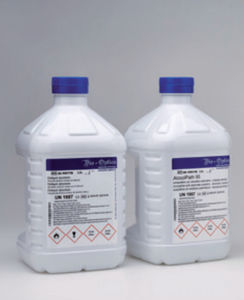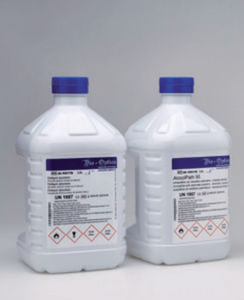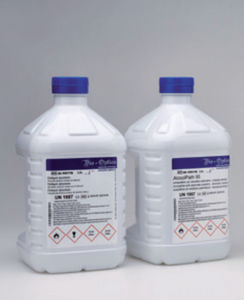
- Laboratory
- Laboratory medicine
- Solution reagent
- BIO-OPTICA Milano
- Company
- Products
- Catalogs
- News & Trends
- Exhibitions
Solvent reagent B-Alcohol 95for histology
Add to favorites
Compare this product
Characteristics
- Type
- solvent
- Applications
- for histology
Description
A 95° alcohol mixture that makes an ideal substitute for 95° ethanol in all histology/
cytology procedures.
Primary container: white bottle in polyethylene terephthalate (PET). Useful capacity 2.5
liters. HDPE cap.
Tamper evident cap.
The polyethylenterephthalate is a thermoplastic polymer of the polyester family. PET is an optimal oxygen, carbon dioxide and other gasses barrier. This material has an high resistance to ultraviolet radiation and an inertia toward the mainly chemical agents (solvents: xylene, limonene, liquid paraffines, alcohols, acids, bases etc.). It is biologically inert. It constitutes a good water and humidity barrier. It shows a great hardness and mechanical resistance.
The bottle has an optimal grip. The absence of the handles reduces space for storage. The anti-dropping cap permits a precise and clean use. Secondary container: carton box.
Through the dehydration process the free water is removed from the tissue.
The process is usually carried out using short-chain alcohols - typically ethanol - with highly polar functional groups that interact strongly and quickly with free water pulling it out from the tissue.
When this process takes place too quickly - as happens in the presence of ethanol - may occur some distortions which confer to tissue negative characteristics such as hardness,
friability and 'shrinkage'. Replacing ethanol (2 carbon atoms linear chain) with isopropanol (3 carbon atoms branched chain) the extraction speed of water is balanced without negative effects.
Dehyol contains isopropanol, while maintaining intact the dehydrating ethanol power, it is less aggressive reducing the phenomena of hardening and shrinkage
Catalogs
No catalogs are available for this product.
See all of BIO-OPTICA Milano‘s catalogsRelated Searches
- Bio-Optica solution reagent
- Laboratory reagent kit
- Bio-Optica histology reagent
- Reagent medium reagent kit
- Bio-Optica cytology reagent
- Bio-Optica stain reagent
- Buffer solution reagent kit
- Bacteria reagent kit
- Bio-Optica staining solution reagent
- Microscope slide
- Sample preparation reagent kit
- Pathology reagent
- Bilirubin reagent kit
- Bio-Optica fixative solution reagent
- Paraffin wax reagent
- Phosphate buffer reagent kit
- Microscopy reagent
- Collagen reagent kit
- Helicobacter pylori reagent kit
- Decalcifying solution reagent
*Prices are pre-tax. They exclude delivery charges and customs duties and do not include additional charges for installation or activation options. Prices are indicative only and may vary by country, with changes to the cost of raw materials and exchange rates.








